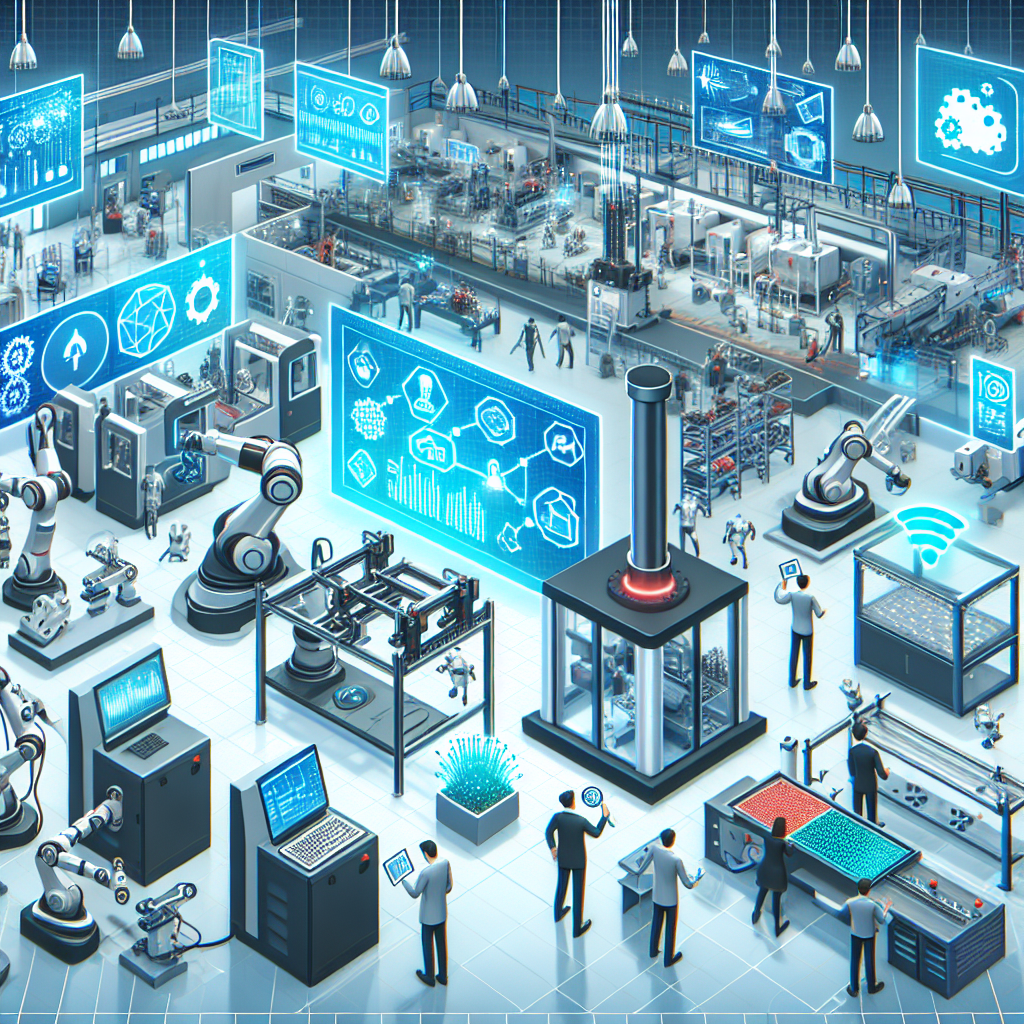Manufacturing – If you’re like me, when you think about manufacturing, you might picture massive factories with rows of machines churning out products day in and day out. But here’s the thing—I’ve seen firsthand just how much manufacturing is changing. Gone are the days of “one-size-fits-all” assembly lines and outdated technology. Today, manufacturing is all about innovation, efficiency, and smart technology. And if you’re not keeping up, you’re at risk of getting left behind.
I remember the first time I stepped into a modern manufacturing facility. The place felt like a mix of high-tech wizardry and science fiction. Robots were working alongside humans, machines were talking to each other, and data was being analyzed in real-time. Honestly, I had to take a moment to process what was happening. It was all pretty mind-blowing, but it was also a sign of what’s coming down the pipeline for the entire industry.
So, whether you’re a small business owner, a manager in a large corporation, or just someone interested in the future of industry—let’s dive into six cutting-edge technologies that are transforming manufacturing and setting the stage for the future. Buckle up, because these innovations are game-changers.

Table of Contents
ToggleThe Future of Manufacturing: 6 Technologies You Need to Know
1. Artificial Intelligence (AI) and Machine Learning
AI is already here, and it’s starting to take over more aspects of manufacturing than we could have imagined just a few years ago. I remember when AI was something I only read about in science fiction books, but now it’s a big deal in the manufacturing sector.
AI helps manufacturers predict problems before they happen. Imagine a scenario where an expensive machine suddenly breaks down—losing hours of work and money. AI-powered systems can use predictive analytics to anticipate machine failure based on historical data and even recommend preventative maintenance. This has the potential to save millions of dollars in repairs and downtime.
And let’s not forget about machine learning, which allows systems to learn from data and improve over time. In a manufacturing context, this could mean optimizing production lines in real time for greater efficiency. So, AI isn’t just for tech giants anymore—it’s for everyone in the manufacturing world.
Pro Tip: If you’re considering AI for your manufacturing operations, start small. Even implementing AI to streamline a single process, like inventory management, can lead to impressive results.
2. 3D Printing (Additive Manufacturing)
Now, this is one that really blew my mind when I first saw it in action. 3D printing (or additive manufacturing) is rapidly revolutionizing how things are made. Instead of using molds or other traditional methods, 3D printers create parts layer by layer, which allows for complex designs and customization at a fraction of the cost.
One of the biggest benefits of 3D printing is the ability to produce prototypes quickly. I’ve worked in several projects where a new part or product had to be tested and reworked multiple times. With 3D printing, manufacturers can quickly print a prototype, test it, and make adjustments before committing to mass production. This means less waste and faster time-to-market for new products.
It’s not just for prototypes either. 3D printing is also being used to produce end-use parts, especially in industries like aerospace and automotive. Talk about efficiency!
Pro Tip: If you’re in manufacturing and haven’t explored 3D printing yet, start with low-cost prototypes. It’s an easy way to get your feet wet and see how it can enhance your operations.
3. Robotics and Automation
Okay, robots aren’t exactly new to the manufacturing world. But here’s the thing—robotics and automation are evolving rapidly, and they’re becoming far more affordable and accessible for smaller manufacturers. When I first saw a robot in action, I’ll admit—I thought it was just another expensive gadget. But when I really dug into how these robots were being used, it changed my perspective.
Today’s robots can work side-by-side with humans, performing repetitive tasks with precision and speed. Whether it’s welding, packaging, or assembly, robots are taking on the heavy lifting, leaving humans to focus on more complex tasks. This leads to a major boost in productivity and consistency.
Another big win is collaborative robots (or cobots). Unlike traditional robots, cobots are designed to work alongside human operators. They don’t need safety cages and can assist workers in real-time, improving efficiency without the risk of injury.
Pro Tip: If you’re looking to implement robotics, start by automating repetitive, low-skill tasks first. It’s a quick win and allows you to see immediate benefits.
4. Internet of Things (IoT)
The Internet of Things (IoT) isn’t just about your smart home devices; it’s also about machines talking to each other in a manufacturing environment. IoT connects sensors, machines, and devices to a network, allowing real-time data to flow seamlessly across the production line.
I’ve seen IoT in action during a factory tour, and it’s like watching the entire system work as a team. Sensors on machines report their performance, and if something’s off, the system will alert managers or trigger an automatic response. This type of real-time monitoring is incredibly valuable for improving operational efficiency and quality control.
The most impressive part? IoT allows manufacturers to collect data and use it to make informed decisions. From maintenance schedules to energy usage, this data helps businesses operate smarter, not harder.
Pro Tip: Start small by integrating sensors into key machines and equipment. Over time, the data you collect will help you uncover hidden inefficiencies and areas for improvement.
5. Augmented Reality (AR) and Virtual Reality (VR)
AR and VR might sound like something out of a video game, but these technologies are making waves in manufacturing, too. Augmented Reality (AR) overlays digital information onto the physical world, while Virtual Reality (VR) creates fully immersive digital environments. Both of these are incredibly useful in training, design, and maintenance.
When I first saw AR used in manufacturing, it blew me away. Technicians could wear AR glasses that provided step-by-step instructions for repairing a piece of equipment. Instead of flipping through manuals, they could instantly access detailed instructions—right in front of their eyes. This reduces downtime and improves accuracy.
On the other hand, VR is being used for things like virtual prototyping and simulations, allowing designers and engineers to test products in a digital space before ever creating them physically. This cuts costs and speeds up the design process.
Pro Tip: If you’re in manufacturing, look into AR training programs for employees. It’s a great way to get workers up to speed quickly while reducing human error.
6. Blockchain Technology
Lastly, let’s talk about blockchain—yeah, the same technology behind cryptocurrencies like Bitcoin. But blockchain isn’t just for digital currencies; it’s also being used to enhance transparency and security in supply chains.
I’ve worked in industries where tracking the origin and journey of materials through the supply chain was a nightmare. Blockchain offers a solution by providing an immutable, decentralized record of every transaction in the supply chain. This makes it easier to verify authenticity, prevent fraud, and improve accountability. Imagine being able to trace a part from the moment it was made all the way to your factory door—blockchain makes that possible.
Pro Tip: If you’re worried about counterfeit goods or fraud in your supply chain, explore blockchain solutions. It’s an investment that will pay off in the long run.
Final Thoughts
Manufacturing is evolving, and the technologies we’ve covered—AI, 3D printing, robotics, IoT, AR/VR, and blockchain—are just the tip of the iceberg. These tools are helping companies become more efficient, cost-effective, and innovative than ever before.
The future of manufacturing is all about automation, data, and smart technology. By keeping up with these trends, you can not only improve your operations but also stay ahead of the competition. The question isn’t whether these technologies are the future—it’s whether your business is ready to embrace them. If you’re not already, it might be time to start thinking about how you can integrate these game-changing technologies into your operations. The future is now, and it’s time to get on board.





